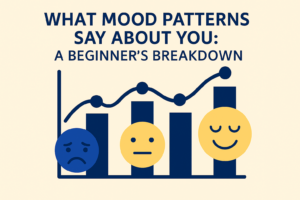
Your mood has a rhythm.
Some days you’re up, other days you’re low. But when you take a step back, those shifts start to form patterns – and they’re often trying to tell you something.
Understanding your mood patterns is one of the most valuable parts of mood tracking. It helps you recognize emotional cycles, spot hidden triggers, and support your mental health with more intention.
In this beginner’s guide, we’ll break down what mood patterns are, how to spot them, and what they might be saying about you.
🧠 What Are Mood Patterns?
Mood patterns are emotional trends that appear over time.
They reflect when and how your mood tends to shift, based on things like:
-
Time of day
-
Days of the week
-
Specific triggers (like social events, sleep, stress, or routines)
-
Lifestyle patterns (like diet, hormones, or seasons)
When you track your mood consistently, those ups and downs start to show repeatable cycles. And that’s where the insight begins.
🔍 Common Mood Patterns (And What They Might Mean)
Here are a few examples you might spot in your own tracking:
📉 Afternoon Dips
If your mood crashes after lunch, it could point to:
-
Low energy
-
Poor sleep
-
Overstimulation from busy mornings
🔁 What to do: Block 20 mins of quiet time or a walk after lunch.
📆 Monday Lows / Weekend Highs
Seeing a weekly emotional rollercoaster?
-
You might feel more freedom on weekends
-
Or stress linked to work routines at the start of the week
🧠 Awareness helps you create better Sunday wind-down rituals.
🚨 Sharp Drops After Certain Events
If your mood plummets after a specific activity or interaction, that’s a clear emotional trigger.
📌 Use tags or short notes to figure out what keeps triggering this.
⚠️ Flat, Unchanging Mood
If every day feels the same, emotionally — especially on the low end — it could suggest:
-
Burnout
-
Emotional numbness
-
Depression
🌱 No judgment here. Just insight. Consistent low mood is a signal, not a failure.
📊 How to Spot Patterns with mindsmiles
Tracking your mood is one thing — but mindsmiles makes it easy to actually see patterns emerge.
Here’s how:
-
✅ Log your mood daily (30 seconds)
-
🧠 Use Support Cards when things feel intense or unclear
-
📈 Review your weekly summaries to spot emotional spikes or dips
-
🗓️ Look at time of day, tags, and journaling notes — they hold valuable clues
No spreadsheets. No pressure. Just simple visuals that reflect your emotional rhythm.
🎯 Why It Matters: Your Mood Is a Map
Understanding mood patterns helps you:
-
Anticipate dips — and soften them
-
Use high-energy times more intentionally
-
Plan self-care before you hit burnout
-
Feel more in control, even during emotional storms
📌 You’re not overreacting — you’re reacting in patterns. And once you see them, you can shift them.
💬 Final Thoughts: Your Mood Is Talking. Are You Listening?
Mood patterns aren’t something to fix — they’re something to understand.
Every emotional high or low is a message.
And the more you track, the better you get at hearing what your mind and body are trying to say.
🌟 Ready to decode your own emotional rhythm?
Try mindsmiles free, and start seeing what your mood patterns reveal — one day at a time.